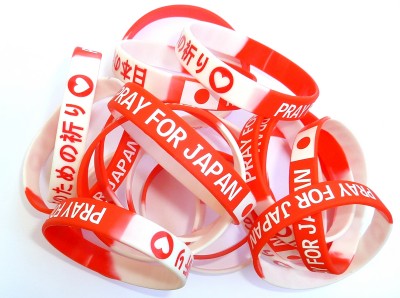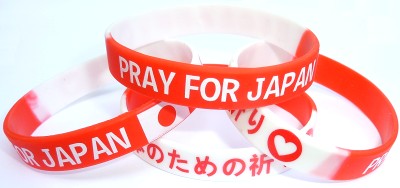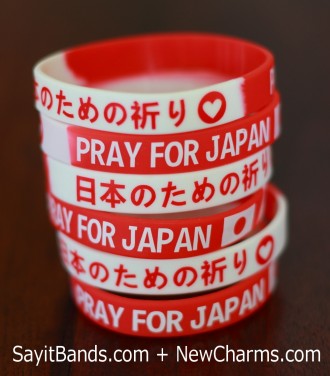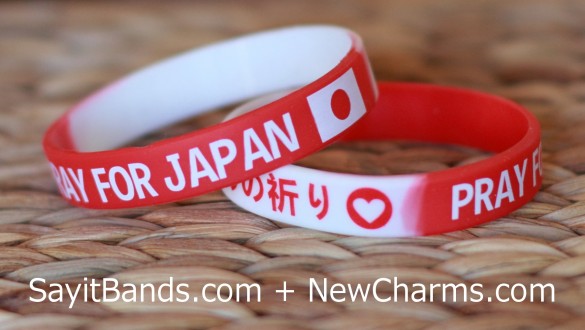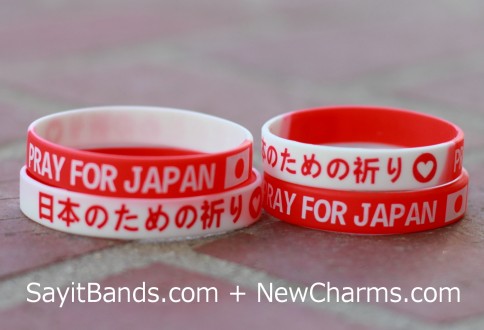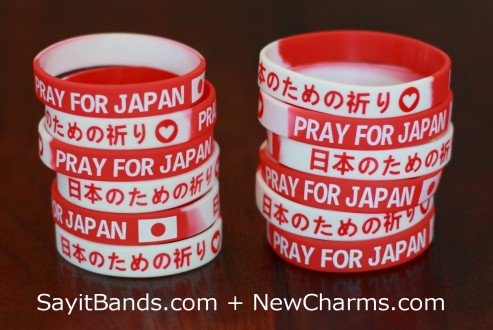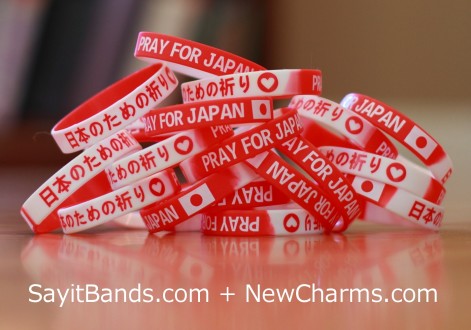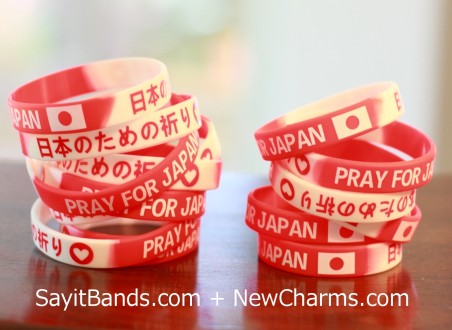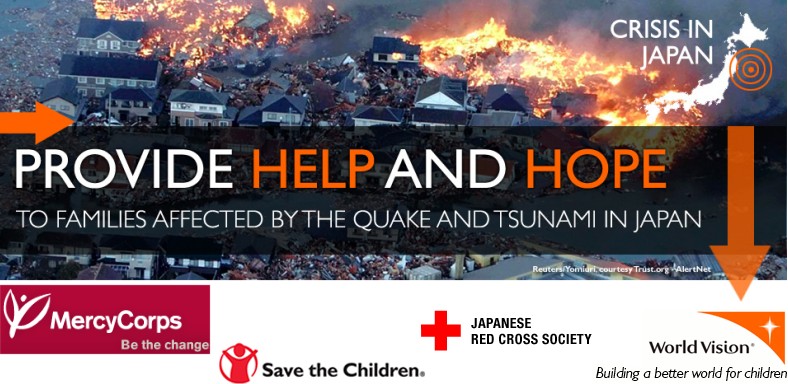|
If
you can give, we recommend donating to the organizations below.
|
|
|
|
|
RECENT NEWS ARTICLES REGARDING THE CRISIS
IN JAPAN
Insurers,
Reinsurers wobble on latest Japan quake
Businessweek
Another earthquake that shook the northern section of Japan rattled the
stocks of insurance and reinsurance companies on Thursday. The magnitude-7.4
aftershock knocked out power across a large portion of the area that was
devastated by the March 11 earthquake and tsunami, which killed about
25,000 people, tore apart entire communities and triggered an ongoing
crisis at a nuclear power plant. A new tsunami warning was issued following
the aftershock, but cancelled about 90 minutes later. In the minutes after
word of the latest quake spread, insurance and reinsurance companies with
exposure to the area saw stocks dive. As it became clear that there was
no heavy damage, shares mainly recovered. Still, the first three months
of this year "will go down in the record books as among the worst
in global underwriting history," analysts at Keefe, Bruyette &
Woods said in a note to clients issued earlier Thursday. The Japan quake
and tsunami, coming on top of the Feb. 21 earthquake in New Zealand and
earlier flooding in Australia, has resulted in tens of millions of dollars
of losses for the industry. The Japan quake alone is likely to be one
of the costliest catastrophes in history -- industry loss estimates climb
as high as $25 billion to $30 billion. KBW warned that another major event
could pressure capital reserves for some companies. It noted that the
industry has been unable to pin down loss estimates, and the nuclear crisis
makes assessment even harder than usual after a disaster.
However, it is widely expected prices will rise as companies reassess
their coverage. That belief sent the sector's stocks up earlier in the
week, with many companies reaching new highs. Among the hardest-hit stocks
in the group Thursday was American Safety Insurance Holdings Ltd. The
Hamilton, Bermuda-based reinsurance company, which estimated it would
record up to $7 million in losses for the first quarter without counting
Japan, saw shares fall $1.09, or 5.1 percent, to $20.38 in afternoon trading.
Also down was ACE Limited, a reinsurance company based in Zurich. Shares
fell 63 cents to $65.85 in afternoon trading. Everest Re Group Ltd., another
Bermuda reinsurer, also dipped. The company said its initial estimate
saw losses in New Zealand at around $180 million and in Australia, around
$45 million. It expects "significant" losses in Japan but has
not yet released an estimate. Shares gave up 31 cents to $93.45.
PartnerRe Ltd. has said it expects to pay out up to $240 million for
the New Zealand quake but has not yet offered estimates for Japan. Shares
of the Pembroke, Bermuda-based reinsurer slipped 28 cents, to $82.24.
Shares of RenaissanceRe Holdings Ltd., also based in Bermuda, slipped
26 cents, to $71.46. It has put its total losses for Australia and New
Zealand at about $220 million, and said Japan losses are likely to be
"material."
Radioactive
traces found in NY likely from Japan
The Wall Street Journal
ALBANY, N.Y. — New York officials say traces of radioactive iodine
likely from the damaged nuclear power station in Japan have been found
at monitoring stations in the state. The state health department describes
the levels as minute and says they don't pose a threat to the public safety.
The department says Tuesday the traces found in air and rainwater are
consistent with findings in other states.
Federal officials say seven states previously recorded slightly elevated
levels of radiation believed to be from the Fukushima Dai-ichi nuclear
plant, which was damaged during the March 11 earthquake and tsunami. They
are Alabama, Alaska, California, Hawaii, Idaho, Nevada and Washington.
Small amounts also have been found in the Pacific islands of Guam, Saipan
and the Northern Mariana Islands.
Can
Japan's disaster help prepare the world for climate change?
Christian Science Monitor
We know that there is always a "silver lining" of disasters.
At a minimum, new government jobs are created as the public demands "action"
and somebody must co-ordinate the rebuilding efforts. Whether the shock
is the Moscow Heat Wave of 2010, 2005 Katrina or 2011 Northern Japan,
how much do we update our prior beliefs in response to a very salient
shock? Permit me to offer some quotes from this article. Mathew is an
economics professor at UCLA and has written three books: Green Cities
(Brookings Institution Press); Heroes and Cowards (Princeton University
Press, jointly with Dora L. Costa); and in fall 2010, Climatopolis: How
Our Cities Will Thrive in the Hotter World (Basic Books). "We can
only work on precedent, and there was no precedent,” said Tsuneo
Futami, a former Tokyo Electric nuclear engineer who was the director
of Fukushima Daiichi in the late 1990s. “When I headed the plant,
the thought of a tsunami never crossed my mind.”
This is a fascinating quote. Mr. Daiichi is implicitly saying that based
on his sampling of history that the probability of a Tsunami affecting
his power plant was 0%. This sounds a little like Wall Street in 2008.
In that case, what was the probability that all U.S local housing markets
declined in value at the same time? It had never happened before so it
couldn't happen. For those who care about adapting to climate change,
this is fascinating stuff. Climate change is likely to raise the probability
of very unlikely nasty events. If these events used to be a 1 in ten million
chance of taking place and now they are a 1 in 100,000 chance of taking
place, then there will be protective investments that will pass a "cost/benefit"
test that could be invested in.
"For some experts, the underestimate of the tsunami threat at Fukushima
is frustratingly reminiscent of the earthquake — this time with no
tsunami — in July 2007 that struck Kashiwazaki, a Tokyo Electric
nuclear plant on Japan’s western coast.. The ground at Kashiwazaki
shook as much as two and a half times the maximum intensity envisioned
in the plant’s design, prompting upgrades at the plant. “They
had years to prepare at that point, after Kashiwazaki, and I am seeing
the same thing at Fukushima,” said Peter Yanev, an expert in seismic
risk assessment based in California, who has studied Fukushima for the
United States Nuclear Regulatory Commission and the Energy Department.
There is no doubt that when Fukushima was designed, seismology and its
intersection with the structural engineering of nuclear power plants was
in its infancy, said Hiroyuki Aoyama, 78, an expert on the quake resistance
of nuclear plants who has served on Japanese government panels. Engineers
employed a lot of guesswork, adopting a standard that structures inside
nuclear plants should have three times the quake resistance of general
buildings." So, in the aftermath of a disaster --- how do risk regulators
recalibrate their subjective risk assessments? Do they tend to "over-react"?
The adaptive process involves both government self-protection investments
and private sector investments. Will people choose to live close to such
plants and in such coastal locations? What materials will they build their
homes out of as they rebuild? The media is reporting that concrete homes
in the Tsunami zone survived the disaster with much less damage than wood
homes. How will this lesson affect the rebuilding effort? Returning to
climate change adaptation, the key issue here is subjective risk assessment.
For voters and day to day citizens, do salient disasters shock people
into changing their lifestyles so that they are protected from the next
disaster? In the case of the Moscow Heat Wave of 2010, I am sure that
this will stimulate air conditioner sales so that next summer's Moscow
Heat will cause much less suffering. Does this optimism hold more broadly?
Or are we doomed to make the same mistakes over and over again because
we do not learn? Economists are sure that people do learn from their mistakes
and increased fat tail risk offers a fascinating test of this optimism.
Coca-Cola
raises Japan relief donations to $31 million
Atlanta Business News
Coca-Cola Co. is raising its pledge of support for relief and rebuilding
efforts in Japan to $31 million over the next three years. The stepped-up
pledge comes less than two weeks after Coca-Cola promised$7.3 million
in cash and beverages in the aftermath of an earthquake and tsunami. It
appears to be one of the largest sums Coca-Cola has ever earmarked for
disaster relief.
Muhtar Kent, chairman and chief executive of Coca-Cola, visited Tokyo
for two days recently to meet with employees and bottlers. He was accompanied
by directors Herbert A. Allen and James D. Robinson III. "We were
very keen to be here in Tokyo to understand clearly what on-the-ground
support is needed for Japanese communities and our business," Kent
said in a statement. "We have been deeply moved by what we have seen
and heard." Coca-Cola is establishing a fund to help rebuild schools
and other facilities that support children. The company said it would
match employees' contributions over the $31 million it has pledged.
Toyota
To Resume Some Hybrid Car Production In Japan
The Wall Street Journal
TOKYO (Dow Jones)--More than two weeks after the devastating quake, subsequent
tsunami and radiation leakage disrupted Japan's northeastern supply chain
operations, Toyota Motor Corp. (7203.TO) will resume production of three
hybrid models in its home market on Monday. The company expects parts
to arrive next week and will use components that it currently holds for
production. But the car maker cautioned that it remains unclear how long
it will continue running production lines to make the Prius, the Lexus
HS250h and the Lexus CT200h hybrids; Toyota said this depends on whether
it will procure enough parts everyday after the restart, despite sending
teams of engineers to suppliers in the quake-hit area to help them restore
operations.
Toyota is following Nissan Motor Co. (7201.TO) in restarting both auto
assembly operations and parts manufacturing after the magnitude-9 earthquake
hit on March 11. Nissan began production of some parts on Monday and assembling
some vehicles on Thursday using parts expected to be procured by then.
Still, Japanese car makers including these two biggest car makers in the
country are in the midst of discussions with most troubled supplies in
the quake-hit area to find out when and how they could start making their
parts, and are yet some way off re-establishing fully their parts supply
destroyed by the massive quake. Toyota, the world's biggest car maker
by volume, will operate its two lines at its Tsutsumi plant in Aichi,
central Japan, to build the Prius which became the best-selling car last
year in Japan. Its Toyota Motor Kyushu Inc. subsidiary will use one of
the two lines at Miyata plant in Fukuoka, south of Japan.
A Toyota spokeswoman declined to elaborate on which parts it expects
to be able to obtain and to name the suppliers. In stark contrast with
the reopening of auto output at the two rivals, Honda Motor Co. said Thursday
that it extended the suspension of auto assembly operations at its two
domestic factories through April 3, as it continues to face parts shortages
due to disruption by the quake. Honda's purchasing staff are visiting
the suppliers stricken by the quake to find ways of quickening parts shipments,
a Honda spokesman said. There are about 10 suppliers of Honda and some
subcontractors are finding it hard to restore operations in northeastern
Japan, the Honda spokesman said. Some workers living within about 30 kilometers
of the crippled Fukushima Daiichi nuclear power plant are staying indoors
as urged by the government, he added. The company, however, will resume
production of motorcycle and power products at its Kumamoto plant from
Monday by using stored parts.
Mitsubishi Motors Corp. (7211.TO) said the same day that it will operate
two of its three domestic vehicle assembly factories on Friday and just
one on Saturday. Suzuki Motor Corp. (7269.TO) is suspending vehicle assembly
output lines on Thursday and Friday and Mazda Motor Corp. (7261.TO) started
temporary auto production on Tuesday. Mazda said Thursday, however, that
it will suspend production of its vehicles in process at its Yamaguchi
plant in western Japan from Monday. Fuji Heavy Industries Ltd. (7270.TO),
the maker of Subaru cars and trucks, said Thursday that it will extend
the period of production suspension at its plant in Gunma in north of
Tokyo to Monday. Even as the stalled shipments of parts by Japanese suppliers
disrupted some foreign car makers, some non-Japanese auto makers will
also begin resumption of production.
The head of Volvo AB's (VOLVY) Asian truck operations Joachim Resenberg
said Thursday that the company is on track to resume operations in Japan
on Monday, while German auto maker Daimler AG (DAI.XE) said on the same
day production will resume gradually over the coming days at its main
Mitsubishi-Fuso commercial vehicles plant outside Tokyo. South Korea's
Hyundai Motor Group isn't facing any disruptions in the supply of automotive
parts from Japan, the group's vice chairman Kim Yong-hwan said. Only seven
out of the 28 Japanese parts suppliers that the group uses are located
in the areas affected by the quakes and Hyundai Motor now plans to place
more orders with the unaffected suppliers to diversify its sourcing, the
vice chairman said.
Japan
Mineral-Water Plants Run at Full Capacity
The Wall Street Journal
TOKYO—Japanese beverage makers are ramping up production of mineral
water amid increasing demand from quake-devastated areas and escalating
fears about radioactive contamination from the heavily damaged Fukushima
Daiichi nuclear plant, and have asked foreign mineral-water producers
to increase shipments to Japan.
WSJ's Yumiko Ono reports confusion reigns in Tokyo over whether tap water
that may be contaminated by radiation is safe for infants to drink. The
Tokyo Metropolitan Government said radioactive iodine levels in Tokyo's
tap water fell to within the government's threshold for consumption by
infants Thursday after rising above the permissible level earlier in the
week, but there are lingering concerns among many Japanese about the safety
of the water.
Coca-Cola (Japan) Co. has been operating all of its seven mineral-water
plants in Japan at full capacity since the March 11 earthquake, a company
spokeswoman said Thursday. There has been some disruption of output at
one of its plants north of Tokyo, due to Tokyo Electric Power Co.'s decision
to implement power outages in its service regions, in order to prevent
more widespread power outages. However, "we are trying to respond
to increasing demand as much as possible," she said. Suntory Holdings
Ltd.'s four domestic mineral-water plants are also running at a full capacity.
Suntory also bottles and distributes PepsiCo Inc. products in Japan.
Residents hoard bottled water after a government warning that the level
of radioactive iodine in some of Tokyo's tap water is high enough to harm
infants. WSJ's Mariko Sanchanta and Yumiko Ono explains what all this
means. Kirin Holdings Co. said its mineral-water business, which imports
Volvic-branded water from France's Groupe Danone SA, has already asked
Danone to send more shipments to Japan. But a Kirin spokesman said it
will take about three months for extra supplies to be shipped via sea
freight, underscoring the difficulty of meeting the short-term surge in
demand. Otsuka Holdings Co.'s beverage unit, which sells Crystal Geyser
mineral-water product lines from the U.S. in Japan, has asked its U.S.
counterpart to increase output to meet increasing orders from retailers
and other business clients.
Domestic sales of mineral water, including domestic output and imports,
amounted to 2.518 million kiloliters in 2010, up 0.4%, according to the
Mineral Water Association of Japan. Imported mineral water accounted for
about 17% of the total. A Tokyo city official said a sample collected
earlier Thursday at the Kanamachi purifying plant in north of Tokyo contained
an iodine-131 reading of 79 becquerels a kilogram, less than the 100 becquerel-a-kilogram
permissible limit for infants. Tuesday, a sample at the Kanamachi waterworks
contained an iodine reading of 210 becquerels a kilogram. Another sampling
Wednesday, also from Kanamachi, showed an iodine reading of 190 becquerels
a kilogram. In line with the elevating levels of the radioactive material,
the Tokyo government said Wednesday that tap water shouldn't be consumed
by infants in Tokyo's 23 wards and several Tokyo cities.
Survivors
Pulled From Wreckage Nine Days After Japan Quake
VOA News
Japanese rescuers have pulled an 80-year-old woman and her grandson alive
from the wreckage of their home in Miyagi Prefecture, nine days after
an earthquake and tsunami devastated the region. Henry Ridgwell visited
in the area and reports for VOA from Miyagi. It is the good news story
that the Japanese people have been craving. An 80-year-old woman and her
16-year-old grandson - found alive and pulled to safety from the wreckage
of their house in Ishinomaki, Miyagi Prefecture.
Local media report they survived by eating yoghurt from the fridge. They
have survived nine nights of freezing temperatures and heavy snow. The
boy is reported to have a low temperature, but is conscious. It will reinvigorate
the rescue effort here. For days Japanese and international teams have
searched up and down the wrecked local coastline in vain. But Miyagi police
say 15,000 people probably died in their prefecture.
On a windswept embankment surrounded by rice paddies and wrecked houses
lies the body of a teenage boy. The boy, wrapped in blankets, lies near
the town of Natori in Miyagi, a nameless corpse yet to be collected and
taken to the overwhelmed morgue. Rescuers say there are many more bodies
among the wreckage of this town. The rest of the missing, they say, were
probably washed out to sea. Natori was on the frontline when the tsunami
smashed into the shoreline. Anyone who had not escaped this flat coastal
plain had little chance. Now a clock hanging from the remains of a house
here is frozen at 2:46 - the moment the earthquake struck.
At the nearby Tozen-ji shrine, Yukihiro Soga cuts a lonely figure. The
granite gravestones lie smashed across the grounds, the shrine building
one of the few in the town to still be standing. Soga has come here to
collect the bones of his parents. “It is not so hard to sift through
the soil, the bone fragments are much lighter than the stones,” says
he. It may seem a grim task, but Soga says it is his duty to his parents.
“The power of the human race is nothing compared to nature he says.
We have to live in harmony with nature. The tsunami caused such huge destruction
that I do not feel anger. I am lucky that my family all survived this.
So we have a new start - we start from zero. I am going to live here with
nature. My roots are here. My parents are here." Like Soga, thousands
of people up and down the coastline have felt the full force of nature,
and must now start from zero.
Officials:
Pressure rises again in Japan reactor
Bloomberg Businessweek
Japan prepared another risky venting of radioactive gas to relieve a
new spike in pressure in one of its troubled nuclear reactors Sunday,
a setback in efforts to bring the crippled, leaking plant under control
just after some signs of improvement.
The planned release into the air of what officials said would be a densely
radioactive cloud comes as traces of radiation are turning up well beyond
the leaking Fukushima Dai-ichi plant after its cooling systems were knocked
by the massive March 11 quake and tsunami on Japan's northeast coast.
Radiation has seeped into the food supply, with spinach and milk from
as far as 75 miles (120 kilometers) showing levels of iodine in excess
of safety limits. Minuscule amounts are being found in tap water in Tokyo
and rainfall and dust over a wider area. Taiwan even reported receiving
a batch of contaminated fava beans imported from Japan.
"I'm worried, really worried," said Mayumi Mizutani, a 58-year-old
Tokyo resident shopping for bottled water at a neighborhood supermarket
out of concern for her visiting 2-year-old grandchild. "We're afraid
because it's possible our grandchild could get cancer," she said.
The rising pressure at one of the reactors in the tsunami-damaged nuclear
complex dealt a setback to the government just as it claimed progress
in a spiraling crisis that has compounded recovery from the catastrophic
natural disasters. On Saturday, officials cited headway in reconnecting
power supplies at two of the plant's six reactors and in cooling other
reactors and fuel storage pools by pouring water on them.
After appearing to have stabilized, the plant's Unit 3 reactor became
troublesome again Sunday.
Pressure rose inside the vessel that contains the reactor core, necessitating
a tricky venting of the gases inside to relieve the buildup, officials
with the nuclear safety and the plant's operator said.
The venting is an "unavoidable measure to protect the containment
vessel," nuclear safety agency official Hidehiko Nishiyama told reporters.
He warned that a larger amount of radiation would have to be released
than when similar venting was done a week ago because more nuclear fuel
has degraded since then.
Nishiyama said experts were hoping to filter the released gas to reduce
radiation, otherwise safety agency officials said "dry venting"
could release 100 times more iodine as well as the radioactive elements
krypton and xenon.
Growing concerns about radiation add to the overwhelming chain of disasters
Japan has struggled with since the 9.0-magnitude quake. The quake spawned
a tsunami that ravaged the northeastern coast, killing more than 8,100
people, leaving 12,000 people missing, and displacing another 452,000,
who are living in shelters.
Fuel, food and water remain scarce for a 10th day in the disaster. The
government in recent days have acknowledged being caught ill-prepared
by an enormous disaster that the prime minister has called the worst crisis
since World War II and that required an immediate, full-scale response.
In the latest admission, another nuclear safety official said Sunday
that the government only belatedly realized the need to give potassium
iodide to those living within 12 miles (20 kilometers) of the nuclear
complex.
The pills help reduce the chances of thyroid cancer, one of the diseases
that may develop from radiation exposure. The official, Kazuma Yokota,
said the explosion that occurred while venting the plant's Unit 3 reactor
last Sunday should have triggered the distribution. But the order only
came three days later.
"We should have made this decision and announced it sooner,"
Yokota told reporters at the emergency command center in the city of Fukushima.
"It is true that we had not foreseen a disaster of these proportions.
We had not practiced or trained for something this bad. We must admit
that we were not fully prepared."
Contamination of food and water compounds the government's difficulties,
heightening the broader public's sense of dread about safety. Consumers
in markets snapped up bottled water, shunned spinach from Ibaraki -- the
prefecture where the tainted spinach was found -- and overall express
concern about food safety.
Experts have said the amounts of iodine detected in milk, spinach and
water pose no discernible risks to public health unless consumed in enormous
quantities over a long period of time.
Drinking one liter of water with the iodine at Thursday's levels is the
equivalent of receiving one-eighty-eighth of the radiation from a chest
X-ray, said Kazuma Yokota, a spokesman for the prefecture's disaster response
headquarters.
No contamination has been reported in Japan's main food export -- seafood
-- worth about $3.3 billion a year, less than 0.5 percent of its total
exports. But the island of Taiwan, just to the south and a huge market
for Japanese goods, said Sunday that radiation had been detected in a
batch of Japanese peas but at levels too small to harm human health.
Regulator
Says Fuel Pools at U.S. Reactors Are Ready for Emergencies
The New York Times
WASHINGTON — The chairman of the Nuclear Regulatory Commission said
Sunday morning that the spent fuel pools at American nuclear reactors
are less vulnerable than the ones in Japan because of steps ordered by
his agency after the attacks of Sept. 11, 2001, including having utilities
prepare to use fire hoses to pump in extra water in the event ordinary
cooling systems are knocked out.
Related
Nuclear utilities were ordered to “identify and pre-stage equipment”
that would be useful in such an emergency, according to commission officials.
They have been reluctant to disclose details, because some preparations
against terrorist attack are classified, but indicate that the preparation
includes locating emergency generators, diesel-driven pumps, hoses and
diesel fuel, as well as setting up procedures.
The chairman, Gregory Jaczko, said on the C-Span program “Newsmakers”
that these preparations give an “extra sense of certainty” about
the ability to withstand events beyond what the plant was designed for.
Also on Sunday morning, Energy Secretary Steven Chu, appearing on Fox
News, indicated he remained confident in the safety of American plants.
But he said the Nuclear Regulatory Commission, an independent agency,
would revisit the issues after the problems in Japan.
He said Americans were “in no danger” and “it’s unlikely
they will be exposed to danger.” He said the 23 American reactors
that use the same Mark 1 design as was used in the Fukushima Daiichi Nuclear
Power Station “are constantly being upgraded” to improve their
safety.
Nevertheless, he said, officials will have to study whether a reactor
like Indian Point, in Buchanan, N.Y., “should remain” and whether
its evacuation plans are adequate given that millions of people live near
the plant, which is 34 miles from Manhattan.
“It’s an N.R.C. decision,” he said. “But the N.R.C.
will be looking at that, I’m sure, based on events. But again this
is not to say that we believe that reactor is unsafe. We believe that
reactor is safe.”
Congress gave the job of regulating nuclear reactor safety to the Nuclear
Regulatory Commission when it broke up the Atomic Energy Commission in
the 1970s. The Energy Department got the job of promoting nuclear power.
It is part of the American response to the Fukushima accident because
it has extensive scientific and engineering capabilities as well as equipment
used for monitoring, and because President Obama had designated Mr. Chu,
who won a Nobel Prize in physics, as the government’s point person
on the accident.
Mr. Jaczko reiterated Sunday that the commission would learn all appropriate
lessons and act as needed, once the facts became available.
The five-member commission is to meet Monday morning to receive a briefing
from its staff about what is known and what is uncertain about events
in Japan. Mr. Jaczko said the agency ought to wait until more information
is in hand before taking action. “It’s important for us to do
this in a methodical way,” he said.
He said, however, that a decision made by the commission a few days before
the earthquake to approve a 20-year license extension for the Vermont
Yankee nuclear plant, which is a near twin of the Fukushima Unit 1 design,
was not affected by the events in Japan, even though the commission staff
is still finishing the paperwork before issuing the license.
If information from Japan makes it advisable to order changes at Vermont
Yankee or other plants, including those that are not approaching the end
of their operating licenses, action will be ordered promptly, he said.
He also said he did not anticipate any delay in the commission’s
approval of new reactor designs or a permit for two new reactors in Georgia
later this year. Mr. Jaczko said information from Japan should be in hand
before the decisions on new plants and new designs are due.
The Nuclear Regulatory Commission has sent 11 experts to Tokyo. Mr. Jaczko
said there were no immediate plans to send them to Fukushima Prefecture.
They are assisting Japanese regulators and the utility that operates the
Fukushima plant, the Tokyo Electric Power Company, from Tokyo, he said.
Mr. Jaczko briefed Mr. Obama on Wednesday about the commission’s
assessment of conditions in Japan. Based on those assessments, the United
States recommended that Americans stay 50 miles from the stricken reactor
complex. Japanese officials have ordered an evacuation out to 20 kilometers
— about 12 miles — and told people out to 30 kilometers, 18
miles, to take shelter.
Mr. Jaczko told Congress last week that one of the spent fuel pools was
dry or nearly dry, a very important development. A dry pool would give
anyone within line of sight a huge radiation dose, and the fuel might
melt and radiation-emitting materials might spread. Japanese officials,
however, have cast doubt on the idea that the pool was ever dry.
Asked about this on Sunday, Mr. Jaczko said that he based his statement
on the “best available information” and still believed it to
be true, although he added that one part of the post-accident investigation
should be to examine information flow. Initial information in an accident
can turn out to be wrong, he said. In this case, loss of electric power
shut down a lot of monitoring equipment at Fukushima, he said. And general
accident conditions do not always lend themselves to good information
flow. “There’s a reason they call it a catastrophe,” he
said.
Fears
of radiation-contaminated food rise in Japan
Los Angeles Times
Fears about the safety of the Japanese food supply grew Sunday as authorities
restricted some produce shipments and advised a town near a damaged nuclear
plant not to drink tap water because of radioactive elements in its supply.
The Health Ministry said that radioactive iodine three times the normal
level was detected in Iitate, a town of about 6,000 people 19 miles northwest
of the Fukushima Daiichi nuclear plant, the Associated Press reported.
That is one-twenty-sixth of the level of a chest X-ray and poses no danger
to humans, a ministry official told the AP.
The warning came as authorities barred shipments of raw milk from the
area and the sale of spinach from neighboring Ibaraki prefecture, news
reports said. Officials have also found traces of radiation in the water
supply in Tokyo and other parts of Japan, as well as in canola and chrysanthemum
greens.
Although officials underline that the levels of contamination are not
immediately harmful to humans, the discoveries have caused new angst in
a population already shaken by a massive earthquake and tsunami, quake
aftershocks, power outages and the threat of a full-fledged nuclear meltdown.
Officials with the Vienna-based International Atomic Energy Agency confirmed
Sunday that measurements at a location less than 30 miles from the stricken
plant showed iodine 131 levels in milk up to 15 times above the level
suitable for infants, Reuters reported. The radioactive element can accumulate
in the thyroid and cause cancer. Another radioactive element, cesium 137,
has also been identified in Japanese food products, Reuters said.
Graham Andrew, a senior official with the IAEA, was quoted as saying
that the contamination was "very localized" and that food produced
in other countries had not been affected by the disaster.
Dramatic
Rescue Gives Hope in Japan
ABC News
Despite growing fears about Japan's nuclear situation, dramatic video
showing the rescue of an 80-year-old woman and her grandson is giving
hope to people around the world.
In the nine days since the devastating March 11 earthquake, the woman,
Sumi Abe, and her grandson, Jin Abe, 16, were unable to pull themselves
out of their earthquake-ravaged home and lived off of yogurt stored in
their refrigerator, according to reports. The grandson was finally able
to flag down rescue workers from the rooftop of their house.
According to The Associated Press, after the pair was taken to the hospital
today, Jin's father Akira Abe, told reporters, "I always believed
they were alive."
Radiation Detected in Milk, Spinach, Water Supply
The Associated Press reported Friday that a young man in a different
city had been rescued in a home eight days after the earthquake, but that
later news reports said he returned after the quake and had only been
trapped for one day.
Still, today's story about the woman and her grandson is giving the Japanese
people a much-needed dose of hope in an otherwise dire situation.
Japanese officials said today that pressure in reactor 3 at the Fukushima
Dai-ichi nuclear plant was rising so sharply that they may consider releasing
radioactive steam to relieve the pressure, even though that would cause
further contamination.
That setback came just after reports that radiation was detected in some
Tokyo water, fava beans exported to Taiwan, spinach and milk. Officials
downplayed the risk of the radiation, however, saying that someone would
need to drink the water for a year to become exposed to radiation equal
to that of a CAT scan.
But the toll is greatest for the firefighters who were first called into
contend with the nuclear reactor.
When asked by reporters about the toughest part of the job, a team leader
of the division that has been working at the reactor broke down.
"My firefighters have [a] very high level of motivation and they
worked very hard. And they've left behind famiiles," said Toyohiko
Tomioka with the Tokyo Fire Department's Fire Rescue Task Force. "I
feel extremely sorry for the families that are left behind. I would like
to offer my apologies and appreciation to them."
The firefighters rallied to conduct the rescues said they left in such
a rush that they had to inform their families by text. One of the firefighters
said his wife wrote back, "I hope that you're the savior of Japan."
Officials also said today that the whole Fukushima plant would be scrapped
after this nuclear situation has been addressed.
The death toll has now surpassed 8,000 and nearly 13,000 are considered
missing, the government said.
New
progress, worries in Japan nuclear crisis
Los Angeles Times
Reporting from Tokyo and Miyako, Japan—
Japan took a step toward possibly getting its nuclear disaster under control
Sunday as electricity to power some reactor cooling systems was restored
and previous efforts to lower reactor temperatures with seawater at the
battered Fukushima atomic energy plant appeared to have had an effect.
But the increased optimism by Japanese officials and Western scientists
alike was tempered by a pressure buildup at one of the plant's six reactors
and a newly emerging crisis — radiation contamination was found in
some food and water supplies in a nation already suffering from a cascade
of troubles.
Although Japan's Health Ministry said the contamination levels were not
immediately harmful to humans, the discovery of higher-than-normal radioactivity
in batches of milk and spinach — and of traces of radioactive iodine
in tap water in Tokyo and elsewhere — stirred new angst in a public
already weary from earthquake aftershocks, blackouts and the threat of
a full-fledged nuclear meltdown.
Early Sunday, consumers at some central Tokyo markets were lining up
to buy milk, which already had been in short supply after milk-carton
factories were knocked out by the quake and tsunami.
"The government keeps urging people to stay calm, but there's a
sense of growing anxiety," said Hiroaki Nakajima, an employee at
the Kimuraya supermarket.
Even before news of the tainted foods, he said, people were hoarding
things that they wouldn't normally buy, like instant noodles, water and
rice. Now, he said, customers ask where the milk and spinach come from.
A series of disasters have been battering Japan since a record-setting
earthquake struck March 11 and a tsunami slammed into the northeastern
coast. At least 8,130 people were killed, and 12,272 are unaccounted for,
according to police.
The tsunami also knocked out cooling systems at the Fukushima Daiichi
nuclear power plant about 150 miles north of Tokyo, causing the complex
to leak radiation.
The concerns about contaminated food over the weekend arose even as more
supplies reached some tsunami-stricken areas on the northeast coast and
as officials of the Tokyo Electric Power Co., the operator of the Fukushima
plant, indicated that connecting electrical cables had helped cool reactor
Nos. 5 and 6.
The company said it was hopeful of restoring electricity to the No. 1
and 2 units as early as Sunday, but it remained to be seen whether that
would restart the cooling system for those reactors, given the extent
of their damage.
"I don't think it is a sure thing at all. All the reactors were
exposed to shock, so who knows if the piping is still intact?" said
Edwin Lyman of the Union of Concerned Scientists in Washington.
Lyman and other experts nonetheless took the restoration of power as
an optimistic sign. It "is absolutely a turning point" in the
battle to cool the reactors, USC nuclear physicist Najmedin Meshkati said.
But later Sunday, Hidehiko Nishiyama, an official with Japan's Nuclear
and Industrial Safety Agency, said pressure inside the No. 3 reactor was
rising despite tons of water sprayed over the weekend. He said that pressure
had to be released to prevent the vessel containment chamber from cracking.
Nishiyama didn't offer a reason for the pressure buildup.
It's not the first time that Tokyo Electric has had to release pressure
from reactors at the site, said nuclear safety agency spokesman Ryohei
Shiomi, but he didn't know how many times it had been done.
"We're trying to get things under control, but we're still in an
unpredictable situation," Chief Cabinet Secretary Yukio Edano said.
In one potentially hopeful development, officials said they planned to
test high voltage power lines as early as Sunday afternoon that would
restore operations to cooling equipment at damaged reactors Nos. 1 and
2.
Experts were not surprised that inspectors found contaminated food. After
the Chernobyl nuclear power plant disaster in 1986, a major cause of the
thyroid disease suffered by children came from consumption of tainted
foods, said Dr. Glenn D. Braunstein, chairman of the department of medicine
at Cedars-Sinai Medical Center in Los Angeles.
Japanese health officials have dismissed such fears, saying that the
amount of radiation detected away from the Fukushima plant is minor. Even
so, traces of radiation in the food supply are a matter of concern.
The amount of radiation found in the milk, if consumed for a year, is
equivalent to levels found in one CT scan. The spinach contamination is
equal to one-fifth the radioactivity in a CT scan. And those levels could
be harmful to children, Braunstein said.
"Children are growing and their organs are growing, so they're very
susceptible to radiation effects," he said. "They really need
to discard the milk from around the reactor disaster."
Dr. Daniel Zurosky, director of radiation safety at the University of
South Carolina School of Medicine, said contamination could also turn
up in fish — a staple of the Japanese diet — from radioactive
material that has entered the water, become part of the food chain and
is consumed by fish.
He said it would be vital for Japanese health authorities to monitor
food. After Chernobyl, "they weren't very forthcoming about radiation.
They had a lot of farmland around there."
Yet there is widespread public perception that Japan hasn't issued timely
and complete information since the outbreak of the nuclear disaster. And
the news of food contamination brought a flood of new complaints and worries.
"The biggest problem is that we're not getting the whole picture
from the government, from the media," said Takamasa Edogawa, 76,
standing with his hands thrust into his jacket pockets, the first in a
line of about 40 people waiting to get into Tokyo supermarket Yoshiya
on Sunday. "We generally know where the spinach and milk were from.
But we don't know exactly where. And if the wind changes, other areas
could be affected by radiation."
Similar feelings of helplessness were echoed in Japan's northeast coast.
In Miyako, Souichiro Tachibana, a teacher who watched his house burn
down after the tsunami hit his town, said officials haven't offered a
lot of options. "Nowhere is safe," he said. "Teach me what
I can do. I'm listening. Where can we run away to?"
Yet at the gymnasium of the Miyako Elementary School, the last day or
two has seen things go from famine to feast as more supplies have arrived.
"Please take some food," volunteer Kiyohiko Sasaki said to visitors.
"We've been here eight days," said Rikuko Tachibana, 61, sitting
on blankets provided by the city, amid neat piles of clothing and belongings
on the floor and evacuees sitting about, bored.
"At the beginning, there wasn't enough food, and it was always rice
balls," Tachibana said. "Now there's too much food. And it's
got more variety. We had cream soup today, boiled eggs, soba noodles,
strawberry jam. And I have some fruit bread here."
A local company has donated thick tatami mats for the evacuees to sit
and sleep on, lending a little civility to the basketball courts. Evacuees
carefully remove their slippers before stepping on the woven grass mats.
Shoichi Nakamura, 58, an evacuee sleeping in the Miyako Elementary School,
said she stayed in the shelter because there's no heat or power at home,
and she feels more secure with other people nearby during aftershocks,
such as the magnitude 5.7 temblor that struck off the coast of Fukushima
prefecture just after 10 a.m. Sunday.
Rikuko Tachibana said she knew about the problems at the Fukushima nuclear
complex but often preferred to talk and gossip rather than watch the news.
"All I can say is, we're cheering the nuclear workers on," she
said. "I want them to please do their best. And foreign governments
and experts, please, please help us."
Light
winds, rain forecast near Japan nuclear plant
TOKYO, March 20 (Reuters) - Light southeasterly winds and drizzle are
forecast for the area around quake-stricken nuclear reactors on the northeast
coast of Japan, the weather agency said on Sunday.
The weather is important in gauging the likelihood of light levels of
radiation leaking from the plant reaching heavily populated areas, especially
Tokyo to the south, or entering the food chain.
So far the wind has blown mainly out into the Pacific.
The damaged Fukushima Daiichi plant, run by Tokyo Electric Power Co.
(TEPCO) , is about 240 km (150 miles) north of Tokyo.
The easterlies are expected to change to light northwesterlies, again
heading into the Pacific, later in the day, according to the forecast.
Some 5-10 mm of rain is forecast over the next 24 hours.
Three hundred engineers have been battling inside the danger zone to
try to cool down the reactors which were ravaged by the quake and tsunami
on March 11.
Officially, at least 8,133 people were killed, with 12,272 more missing.
But police said on Sunday they feared more than 15,000 people had been
killed in the one prefecture of Miyagi alone.
The wind near the plant will blow as fast as five metres (16 ft) per
second, the Meteorological Agency in Fukushima prefecture said.
On Saturday, traces of radiation exceeding national safety standards
were found in milk from a farm about 30 km (18 miles) from the plant and
in spinach grown in neighbouring Ibaraki prefecture, the first discovery
of contaminated food since the disaster.
Tiny levels of radioactive iodine have also been found in tap water in
Tokyo, one of the world's largest cities. Radiation has also been found
in dust in the greater city area.
Many tourists and expatriates have already left and residents are generally
staying indoors.
Officials:
Pressure rises again in Japan reactor
USA Today
TOKYO (AP) — Japan's nuclear safety agency said pressure is again
rising in one of reactors at the country's tsunami-damaged nuclear complex
— a setback ...
Japan
quake, tsunami death toll exceeds 7600 as aid arrives
The Hindu
AP AP Mizue Yamamura, 76, cries in the area around her damaged apartment
building for her husband in Onagawa, northeastern Japan. Ms. Yamamura
said that ...
|


